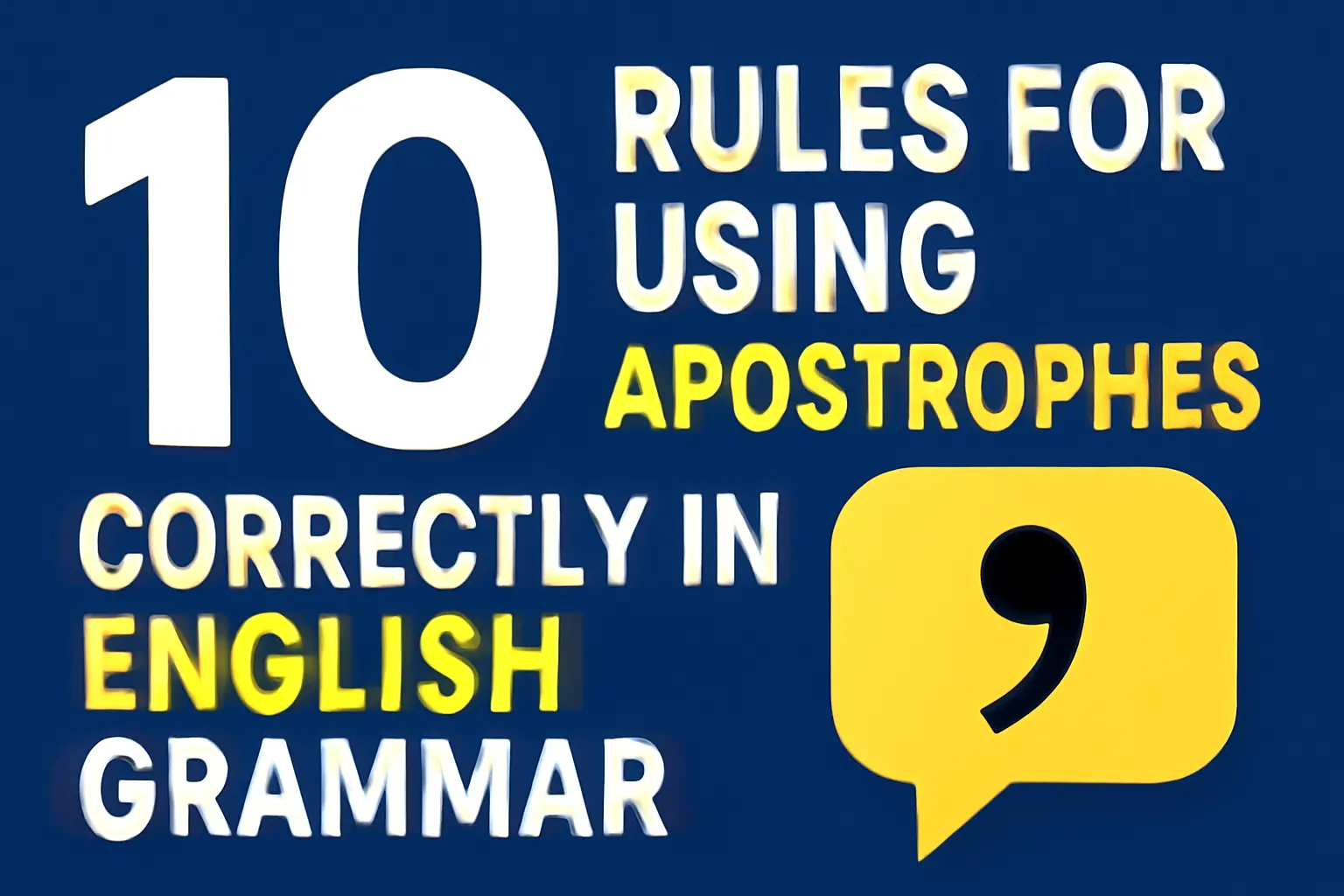In this article, we’ll explore the 10 essential rules for using apostrophes correctly in English grammar. Whether you’re a beginner or looking to refresh your knowledge, these simple yet important guidelines will help you master apostrophes in no time. From possession to contractions, we’ve got you covered with clear examples to improve your writing.
Introduction to Apostrophe Usage
The apostrophe is a small but mighty punctuation mark in English that plays a vital role in writing. It helps indicate possession, form contractions, and clarify meanings in sentences. Mastering apostrophe usage is essential for clear and professional writing. Whether it’s showing ownership or shortening words, the apostrophe adds clarity and ensures the reader understands the intended message.
Also Check: Figurative Language Anchor Chart
Incorrect apostrophe use can easily confuse readers and disrupt the flow of the text. For instance, mixing up “its” and “it’s” or using an apostrophe in plural forms can lead to misunderstandings. Such errors can make a writer seem unprofessional and detract from the overall quality of their work. By mastering apostrophe rules, writers can enhance their writing skills and present themselves more confidently, whether in emails, essays, or professional documents. Proper punctuation helps maintain the integrity of the content, ensuring that the writer’s ideas are communicated effectively and without distraction.
10 Rules for Using Apostrophes

Rule 1: Use Apostrophes for Possession
Apostrophes are essential for showing possession in English. When something belongs to someone or something, an apostrophe is used to indicate ownership. For example, “The cat’s toy” clearly shows that the toy belongs to the cat. This rule helps clarify who or what possesses the object, making the sentence more precise.
In the case of singular possessives, an apostrophe is added before the “s” (e.g., the dog’s bone). However, when dealing with plural nouns that already end in “s,” the apostrophe is placed after the “s” (e.g., the dogs’ bones). It’s important to note the distinction between singular and plural possessive forms. Singular possessives show ownership of one item or person, while plural possessives indicate ownership by more than one.
By following this simple rule, writers can avoid confusion and ensure their writing is both clear and professional. Understanding apostrophes for possession is a key step in mastering English punctuation.
Rule 2: Don’t Use Apostrophes for Plural Nouns
Apostrophes are not needed to form regular plurals. It’s a common mistake to add an apostrophe when making a noun plural, but it’s not necessary. For example, the incorrect sentence “The dog’s are barking” should simply be “The dogs are barking”.
This rule helps keep writing clear and simple. Many writers mistakenly use apostrophes when they’re just pluralizing a word, like “apple’s” instead of “apples”. Avoiding this mistake ensures your writing is more professional and easier to read.
By remembering that apostrophes are for possession or contractions, not plurals, writers can keep their punctuation in check and improve their overall writing skills.
Rule 3: Use Apostrophes for Contractions
Apostrophes are used in contractions to replace missing letters, making speech and writing more fluid. In everyday language, contractions like “I’m” (I am) or “don’t” (do not) are commonly used to shorten words and make communication smoother.
This rule is essential for informal writing or when aiming for a conversational tone. For instance, instead of writing “I am going to the store”, using “I’m going to the store” feels more natural and engaging.
By mastering the use of apostrophes in contractions, writers can improve the readability of their content, making it sound more human and less formal.
Rule 4: When to Use Apostrophes for Plural Possessives
When writing plural possessives, apostrophes are added after the “s” to show ownership. For example, “The teachers’ lounge” indicates that the lounge belongs to multiple teachers. This rule helps clarify possession in cases where more than one person or thing owns something.
The key distinction here is between plural nouns and plural possessives. While plural nouns refer to more than one item (e.g., teachers), plural possessives show that those items own something (e.g., teachers’ lounge). By understanding this difference, writers can use apostrophes correctly and avoid confusion in their writing.
Rule 5: Use Apostrophes for Irregular Plurals
Apostrophes are still necessary for possession with irregular plural nouns. Even though these words don’t follow the regular plural form, they still require an apostrophe to indicate ownership. For example, “The children’s toys” shows that the toys belong to multiple children.
Irregular plurals like children, men, or women need apostrophes to form the possessive. So, it’s the men’s shoes and the women’s handbags, not the mens’ shoes or the womens’ handbags.
By understanding which irregular plurals require apostrophes, writers can avoid mistakes and ensure clarity in their writing.
Rule 6: Avoid Misplacing Apostrophes in Decades
When referring to decades, apostrophes should not be used. Many writers mistakenly add an apostrophe when talking about a time period, like “The 1990’s”. The correct way to write it is “The 1990s” without the apostrophe.
Apostrophes are often misused in time expressions because people assume they indicate possession. However, decades are simply plural forms of a number and don’t require an apostrophe. By avoiding this mistake, writers can ensure their writing is precise and professionally presented, especially when discussing historical or cultural time periods.
Rule 7: Use Apostrophes for Singular Nouns Ending in ‘s’
When a singular noun ends in “s,” an apostrophe is used to show possession. You can either add just an apostrophe or an apostrophe followed by an “s” depending on the style guide you follow. For example, James’ book or James’s book both indicate that the book belongs to James.
To simplify, if the singular noun is a proper name ending in “s,” you can choose either form, but consistency is key. Writers should pick one style and stick to it throughout their writing. By mastering this rule, writers can ensure their sentences are grammatically correct and easy to understand.
Rule 8: Use Apostrophes for Plural Possessives of Irregular Nouns
Irregular plural nouns still require an apostrophe to show possession. For example, in “The geese’s migration path”, the apostrophe comes after the s to indicate that the migration path belongs to multiple geese.
It’s important to note the difference between regular and irregular plurals. Regular plurals simply add an s (like dogs), while irregular plurals can change form (like children or geese). Regardless of whether a plural is regular or irregular, the apostrophe comes after the s in possessive forms. This rule helps keep writing clear and ensures proper ownership is shown in both regular and irregular plural nouns.
Rule 9: Use Apostrophes in Time Expressions
Apostrophes are used in time expressions to indicate possession or a span of time. For example, “A day’s work” shows that the work belongs to a day, while “A week’s vacation” indicates that the vacation lasts for a week.
These expressions help clarify the amount of time involved in an activity or event. When referring to time in this way, always remember to add the apostrophe before the s. This rule applies to other time expressions like “A month’s notice” or “An hour’s delay”. By using apostrophes correctly in time expressions, writers can ensure their writing remains clear and precise.
Rule 10: Avoid Apostrophes in Plural Forms of Acronyms and Numbers
Apostrophes should not be used when making acronyms or numbers plural. For example, “The 1990’s” is incorrect, while “The 1990s” is correct. Similarly, “The CEO’s” is wrong, and it should be written as “The CEOs”.
The common mistake of adding apostrophes to acronyms or years often comes from confusing possession with pluralization. However, when referring to more than one item, simply add an s without the apostrophe. By following this rule, writers can ensure their writing is both accurate and professional, avoiding confusion and improving clarity in their work.
Conclusion
Understanding and using apostrophes correctly is essential for clear and professional writing. Whether showing possession, forming contractions, or handling time expressions, the apostrophe plays a key role in making writing precise and easy to understand. Writers should always proofread their work and double-check apostrophe usage to avoid confusion and ensure clarity.
A fun tip for remembering apostrophe rules: Think of an apostrophe as a “helper” that shows ownership or replaces missing letters. If it’s not showing possession or shortening a word, it likely doesn’t belong! By following these simple rules, writers can master apostrophes and improve their writing. Also use our tool: Free Image Converter Online

